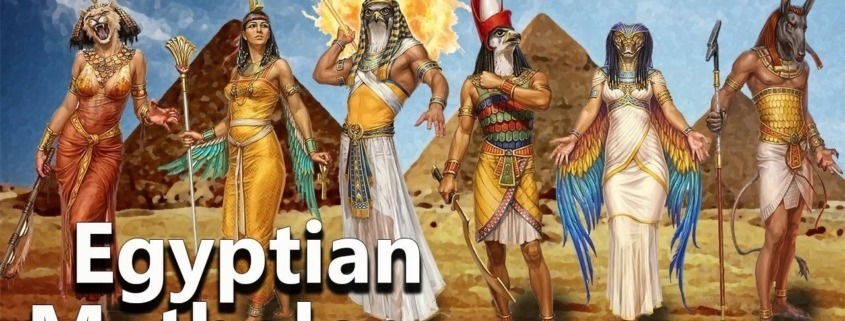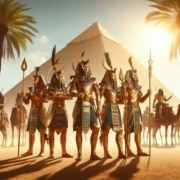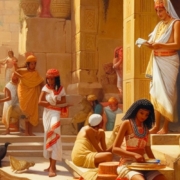Ancient Egyptian mythology
Ancient Egyptian mythology is a rich tapestry of stories, gods, and rituals that played a crucial role in the daily lives, religious practices, and cultural identity of ancient Egyptians. Here’s a deep dive into the fascinating details and lesser-known aspects of this intricate belief system:
Creation Myths and Cosmology in ancient Egypt
1. Primeval Waters (Nun):
– The ancient Egyptians believed that before the world existed, there was only the dark, chaotic waters of Nun. From these waters emerged the first land, symbolized by a mound, and the first god, Atum.
2. Ennead of Heliopolis:
– Atum created the first divine couple, Shu (air) and Tefnut (moisture), who in turn produced Geb (earth) and Nut (sky). Geb and Nut’s children included Osiris, Isis, Seth, and Nephthys, forming the Ennead, or group of nine deities, of Heliopolis.
3. Ogdoad of Hermopolis:
– In another creation myth, the Ogdoad, a group of eight deities (four male-female pairs) represented the primordial elements of chaos: water, air, darkness, and infinity. These gods were believed to have created the world in Hermopolis.
Major Deities and Their Roles in ancient Egypt
1. Osiris:
– God of the afterlife, resurrection, and agriculture. Osiris was murdered by his brother Seth and resurrected by his wife Isis, symbolizing the cycle of life and death.
2. Isis:
– Goddess of magic, motherhood, and fertility. She was instrumental in resurrecting Osiris and protecting their son, Horus.
3. Horus:
– Sky god often depicted as a falcon. Horus avenged his father Osiris’s death by defeating Seth and became a symbol of kingship and protection.
4. Anubis:
– God of mummification and the afterlife. Anubis guided souls to the afterlife and weighed their hearts against the feather of Ma’at (truth).
5. Ra:
– Sun god and supreme deity. Ra traveled through the sky by day and the underworld by night, battling the serpent Apophis to ensure the sun’s rebirth.
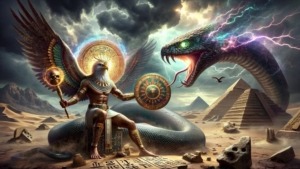
Rituals and Beliefs in ancient Egypt:
1. Mummification:
– Essential for ensuring the deceased’s journey to the afterlife. The process involved removing internal organs, drying the body with natron, and wrapping it in linen.
2. Book of the Dead:
– A collection of spells, charms, and formulas to guide the deceased through the underworld and secure a favorable judgment in the afterlife.
3. Temples and Priesthood:
– Temples were the homes of gods on earth. Priests performed daily rituals, including offering food and drink to the deities and reciting hymns.
Symbolism and Iconography in ancient Egypt
1. Ankh:
– The symbol of life. Often depicted in the hands of gods, representing eternal life.
2. Djed Pillar:
– Symbolizing stability and the backbone of Osiris. It was associated with resurrection and eternal life.
3. Eye of Horus (Wedjat):
– A symbol of protection, healing, and restoration. It was often used in amulets and jewelry to ward off evil.
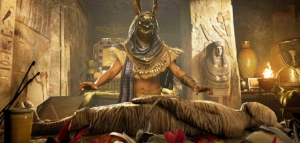
Secrets and Lesser-Known Details of ancient Egypt:
1.Hidden Tombs:
– Many royal tombs in the Valley of the Kings were designed with secret chambers and false passages to deter tomb robbers.
2. Mysterious Deities:
– Some gods, like the serpent Apophis, represented chaos and were considered necessary antagonists in the order of the universe.
3. Magic and Spells:
– Magic (heka) was an integral part of daily life and religious practice. Spells were used for protection, healing, and ensuring success in the afterlife.
4. Animal Worship:
– Animals were sacred and often associated with specific gods. For example, cats were linked to Bastet, the goddess of home and fertility.
5. Amarna Period:
– Pharaoh Akhenaten temporarily shifted worship to the Aten, a sun disk, promoting monotheism. This period was marked by dramatic changes in art and religious practices.
Conclusion
The mythology of ancient Egypt is a complex and deeply symbolic system that reflects the civilization’s values, fears, and hopes. From creation myths to elaborate funerary practices, the ancient Egyptians’ belief in the divine shaped every aspect of their world, leaving a legacy that continues to captivate and mystify us today.
If you would like to know more about the ancient Egyptian mythology and visit many royal tombs and temples from the Pharaohs time check this link here for more details
Written by ATW July 2024

